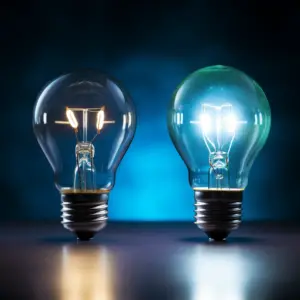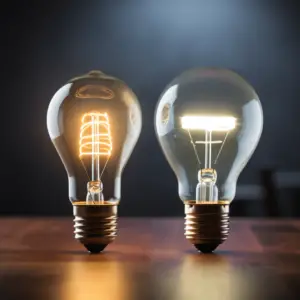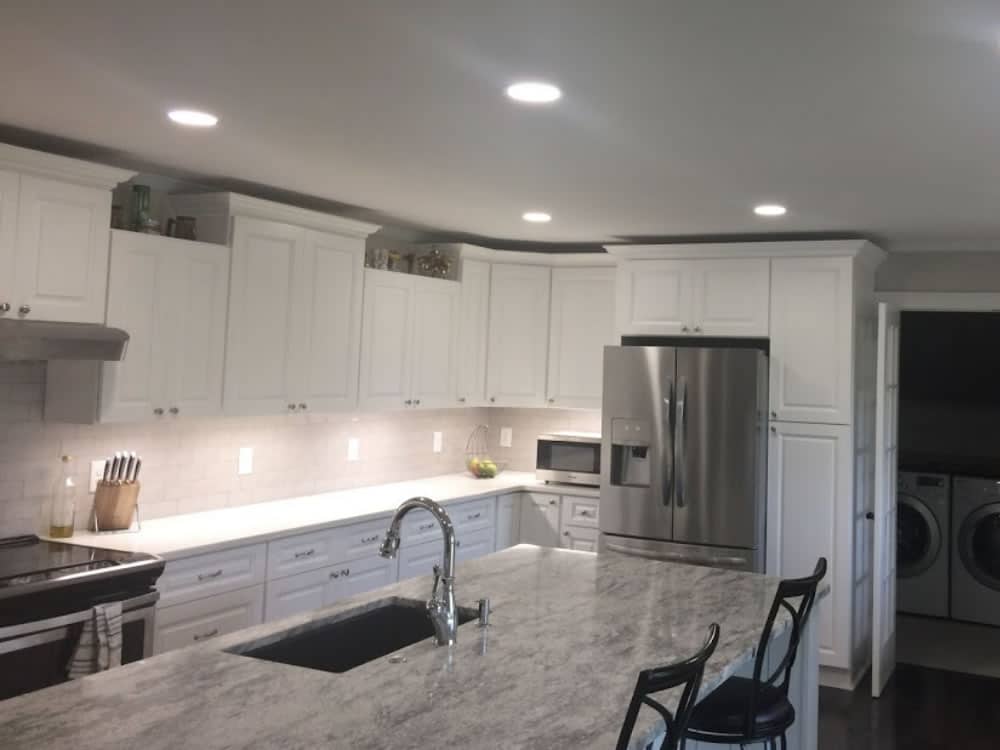The development of technology in the lighting industry has led to the inventions of various lighting systems/sources such as light-emitting diodes (LEDs), recessed lighting, and incandescent lights.
LEDs and incandescent lighting sources have dominated the industry due to their high efficiency and functionality. Ever wondered which one is more superior to the other?
Here is a head-to-head comparison of the two, followed by an in-depth discussion of each technology.
Table of Contents
LED Recessed Lighting Vs Incandescent: Overview

Incandescent Lights
The incandescent lights produce light by heating a wire filament to a temperature that results in a light generation.
The metal wire is surrounded by a translucent glass bulb filled with inert gas or evacuated.
Common applications for incandescent lighting include residential and interior lighting because of their short lifespan and low energy efficiency.
- Advantages Incandescent lights
They’re cheap to manufacture and purchase and they are adaptable to a large range of voltages, light outputs, and current and have a good ability to render color.
The color rendering index (CRI) for an incandescent bulb with a color temperature of 2700K is 100 (a perfect score).
The three primary options for consumers include Soft White (roughly 2700K – 3000K), Cool White (3500K – 4100K), and Daylight (5000K – 6500K).
As color temperature rises, the CRI ratings drop slightly but typically remain above 95 (considered an excellent rating).
- Disadvantages of Incandescent lights
Incandescent lights have low energy efficiency. Most of the energy they consume (~90%) goes into generating heat.
In addition, the Incandescent lights have a low lifespan on the market, the average bulb lasts around 1200 operating hours.
Even though incandescent bulbs are cheap to purchase, you have to buy many (50-100), hence high maintenance costs.
Furthermore, they are omnidirectional, and this is a large system inefficiency because some might need to be redirected to the desired area.
They are costly over time based on the inefficient way they operate and the frequency with which they must be replaced.
Light Emitting Diode (LED) Recessed Lighting
A diode is an electrical device with two electrodes through which electricity flows in only one direction. Diodes are generally made from semi-conductive materials such as silicon or selenium.
LED lights are an excellent solution and adaptable to large public places because of their high longevity. LEDs are ideal lights for purposely turning on and off instantenously because they respond instantaneously.
Advantages of LED lights
LEDs have an extremely long lifespan. New LEDs can last 50,000 to 100,000 hours or more.
They are extremely energy efficient because they waste very little energy, emit light directionally, have high light quality, low maintenance costs and require few accessory lamp parts.
LEDs can be designed to generate the entire spectrum of visible light colors without having to use the traditional color filters required by traditional lighting solutions, much smaller than other lights, and provides an incredibly better variety of high Color Rendering Index (CRI) options to the user.
Disadvantages of LED lights
They are relatively expensive as the up-front costs are very high, transformer compatibility performance standardization has not yet been streamlined, overheating can cause reduced lamps, and they are not compatible with traditional incandescent dimmers.
LED Vs. Incandescent Lighting: Which One Is The best?
Efficiency
LEDs are very efficient relative to incandescent bulbs. Typical source efficiency ranges between 37 and 120 lumens/watt.
However, Incandescent lights have poor efficiency because so much of the energy (90%) goes towards generating heat instead of light. Their source efficiency is around 10 lumens/watt, and their system efficiency is even lower.
Heat emissions
LEDs emit very little forward heat. The only real potential downside is when LEDs are used for outdoor lighting in wintery conditions.
Snow falling on traditional lights like HID will melt when it comes into contact with the light. It’s usually overcome with LEDs by covering the light with a visor or facing the light down towards the ground.
Incandescent lights emit roughly 90% of their emissions as heat. In some circumstances, heat emissions could be beneficial. However, it is generally bad to emit heat as it represents an energy inefficiency. The ultimate purpose of the device is to emit light, not heat.
Failure characteristics
LEDs fail by gradually dimming because they typically operate with multiple light emitters in a single luminaire. The loss of one or two diodes does not mean failure of the entire luminaire.
Incandescent lights are generally hard to fail. They stop working completely at once. Incandescent lights burn well throughout their lifetime, but the extremely limited lifetime makes them a real bear with maintenance and replacement costs.
Maintenance costs

LEDs lights are by far the best regarding lifetime costs. In contrast, Incandescent lights will likely need to be purchased 20-50 times, and the associated labor costs will need to be paid to attain the equivalent lifespan of a single LED light.
Shock resistance
LEDs are solid-state lights that are difficult to damage with physical shocks. However, Incandescent bulbs are fragile as they operate using a filament encased by a glass bulb.
Size
LEDs can be extremely small and scaled to a much larger size, but Incandescent lights come in all shapes and sizes but are typically used for indoor and residential applications where size is not a major factor.
Heat Tolerance
LEDs are fine for all normal operating temperatures, both indoors and outdoors. They do, however, show degraded performance at significantly high temperatures, and they require significant heat sinking, especially when in proximity to other sensitive components.
Incandescent lights generally do not require a warm-up time, but there can be a short delay as the filament heats up when operating at extremely cold temperatures.
Conclusion
Both LED recessed lighting and incandescent lighting function pretty well.LED lights have high longevity and CRI, while incandescent lights are brighter and dimmable.
Both are characteristically good, thus creating dilemmas for customers. However, this article has provided useful and important information for every potential customer.


